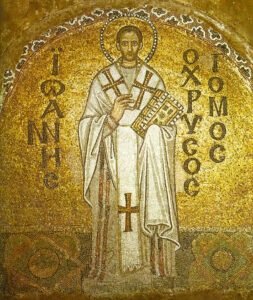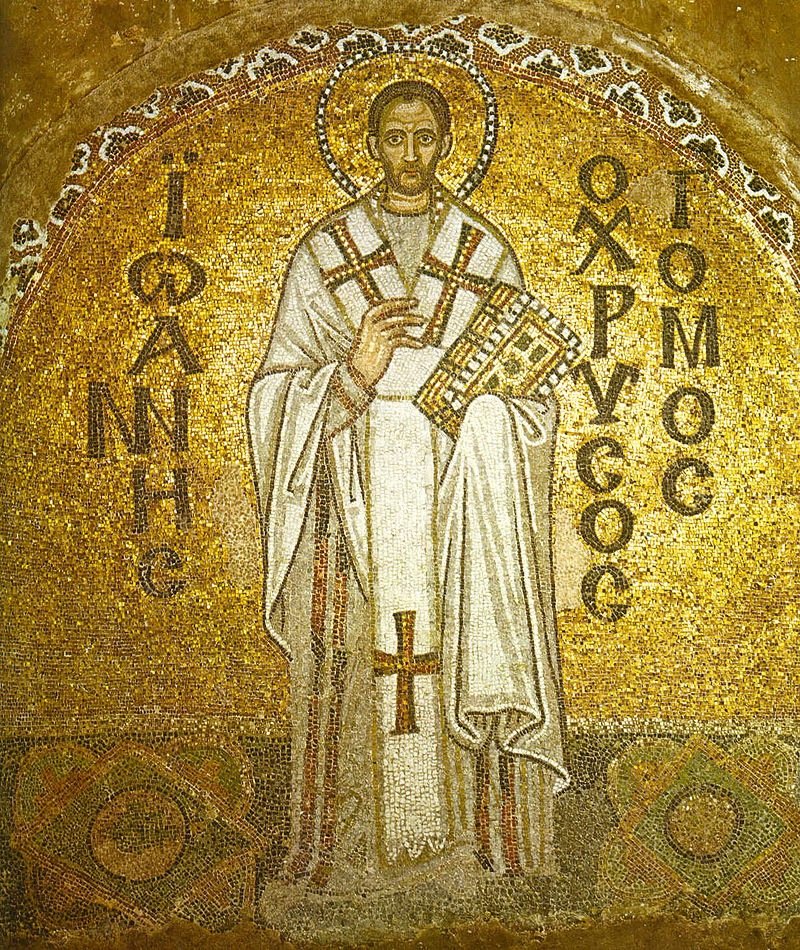How to Pray Prayers of St John Chrysostom: 13 Top Tips To Transform Your Prayer Life
The beautiful and profound Prayers of St John Chrysostom have nourished Christian souls for over 1500 years. These Prayers of St John Chrysostom, though ancient in origin, still offer much meaning and comfort to believers today. There is an enduring power in their poetic words that transcends time and place. The Prayers of St John Chrysostom transport us back to the early Byzantine church era, yet the petitions they contain resonate with the same intimacy and sincerity now as then.
In this blog post I want to explore these timeless prayers—both their history and their continued relevance. We’ll look at how the Prayers of St John Chrysostom emerged, their role in Orthodox liturgy and personal devotion, and why Christians across denominations and centuries have valued these short but spiritually rich prayers.
There is always more depth to plumb in prayers that generations have preserved and cherished. My hope is that through studying the Prayers of St John Chrysostom you’ll find fresh inspiration from these ancient words and a strengthened connection to the wider Body of Christ that has treasured these petitions aloud through the ages.
Let’s begin by looking back at who St. John Chrysostom was, so we can better understand the context behind these beautiful prayers.

Who was St. John Chrysostom?
St. John Chrysostom was one of the most influential early church fathers and saints. He lived in the 4th century AD and served as the Archbishop of Constantinople from 398 up until his death in 407.
St. John got the epithet “Chrysostom” which means “golden-mouthed” in Greek, because of his eloquent and impactful preaching. He is known for his sermons and extensive writings on theology and Christian living. Over 800 of his homilies have survived today, more than any other church father.
St. John Chrysostom is recognized as a saint in Eastern Orthodox, Catholic, Anglican, and Lutheran churches. He is renowned for his insights into scripture, advocacy for social justice, and talent for preaching. St. John Chrysostom is considered one of the Three Holy Hierarchs in Eastern Orthodoxy, along with St. Basil the Great and St. Gregory of Nazianzus.
Some key facts about St. John Chrysostom’s life include:
– Born around 349 AD in Antioch in the Roman Empire, which is in modern-day Turkey
– Studied rhetoric under the pagan teacher Libanius
– Baptized as an adult around 367 AD and then became an ascetic monk
– Ordained as a deacon in 381 AD and a priest in 386 AD in Antioch
– Appointed as Archbishop of Constantinople in 398 AD by Emperor Arcadius
– Died in exile from Constantinople on September 14, 407 AD
St. John Chrysostom was a pivotal leader in the early church, especially renowned for his impactful homilies and speeches aimed at inspiring Christians in their faith and practice.
When did St. John Chrysostom live?
As mentioned in the previous section, St. John Chrysostom lived during the 4th and early 5th centuries AD. He was born around 349 AD in the city of Antioch when it was part of the late Roman Empire.
Some key dates in St. John Chrysostom’s life include:
349 AD – Born in Antioch in the Roman Empire
367 AD – Baptized as a Christian at age 18
381 AD – Ordained as a deacon in Antioch
386 AD – Ordained as a priest in Antioch
398 AD – Appointed as Archbishop of Constantinople at age 49
403 AD – Deposed from Archbishop position on false charges
404 AD – Forcibly removed from Constantinople and sent into exile
407 AD – Died in exile from illness and exhaustion at age 58
So in summary, St. John Chrysostom lived during an important transitional time for the Roman Empire and the Christian church in the late 4th and early 5th centuries AD. He lived to age 58 and served as a priest and influential church leader in Antioch and Constantinople during his lifetime.
St. John Chrysostom’s writings and theology were foundational for both the Eastern Orthodox and Roman Catholic churches. He is considered the most prolific and influential of the early Greek church fathers.
What are the Prayers of St. John Chrysostom?
The Prayers of St John Chrysostom are a set of three prayers that are traditionally used in many Orthodox, Catholic and Anglican worship services and private devotional practices.
These three prayers are:
1. The Prayer Before Holy Communion
2. The Prayer After Holy Communion
3. The Prayer Before Reading Scripture
The Prayers of St John Chrysostom are attributed to him, but some scholars believe they may have been composed later by others to honor him. Regardless of exact authorship, these prayers have been passed down under St. John’s name for over 1,500 years.
They are short yet profound petitions focused on requesting God’s guidance, illumination and discernment, especially related to partaking in communion, reading Scripture, and deepening one’s spiritual life in Christ.
These famous Prayers of St John Chrysostom capture his spirituality and love for Christ in a concise yet poignant way. Many find their repetition helpful in focusing the mind and heart in worship and personal devotion.
What is the history and background of these prayers?
The Prayers of St John Chrysostom emerged as an important liturgical tradition in the Orthodox, Catholic and Anglican churches between the 5th and 8th centuries AD.
The Prayer Before Holy Communion and the Prayer After Holy Communion are the oldest and most established of the set. Various records show these two prayers already in regular use in worship services by the 6th century AD.
The Prayer Before Scripture Reading developed a little later, perhaps during the 8th century AD. This prayer quickly gained the same popularity and status as the other two.
Various ancient manuscripts and liturgical books throughout the Middle Ages contain and make reference to the Prayers of St John Chrysostom as accepted and valued traditions.
While the exact origins are uncertain, the prayers reflect the spirituality and concerns of St. John and other early Greek theologians. The communion prayers connect closely to early Christian worship practices that developed in the first centuries after Christ.
So in summary, the Prayers of St John Chrysostom have ancient roots that developed during the Christological controversies and growth of liturgical worship traditions in the early Byzantine era of Christianity. They remain treasured traditions over 1,500 years later.
What are the different types or sections of the Prayers of St. John Chrysostom?
The Prayers of St John Chrysostom consist of three distinct prayers focused on preparation for communion, thanksgiving after communion, and enlightenment when reading Scripture.
The three parts or types of prayers are:
**Prayer Before Holy Communion**
– Asks God for unity with Christ through communion and forgiveness of sins
**Prayer After Holy Communion**
– Thanks God for permitting participation in the sacred mysteries and requests aid in remaining in Christ
**Prayer Before Reading Scripture**
– Requests illumination, pure thoughts, and discernment from studying Scripture
Each prayer follows a similar pattern but with distinct content and petitions related to their specific purpose within the Orthodox liturgy and personal piety.
The Prayer Before Communion and the Prayer After Communion are the most commonly used pair. The Prayer Before Scripture reading sometimes accompanies the other two but can also stand alone as a prayer before studying or encountering the Bible.
These three prayers cover key spiritual themes surrounding preparation, participation and reflection on communion and studying Scripture within the Christian faith.
What themes and topics are covered in these prayers?
The Prayers of St John Chrysostom touch on a few important spiritual themes and topics common to early Byzantine Christianity:
Communion – All three prayers connect to the Eucharist and Holy Communion, asking for preparation, blessing, and discernment in taking part in this sacrament.
Forgiveness of Sins – The prayers ask God for mercy, forgiveness and cleansing from sins.
Unity with Christ – There is a repeated request to grow closer to Christ in unity through communion.
Discernment – The prayers ask God for spiritual discernment and wisdom in understanding Scripture and the truths of the faith.
Illumination – A petition for God to illuminate the mind and heart is present in the prayers.
Unworthiness – The prayers emphasize human imperfection and not deserve such blessings from God.
Pure Thoughts – One prayer asks God to allow and enable the reader to hold to pure thoughts.
Guidance – The requests emphasize seeking God’s guidance and truth rather than one’s own limited faculties.
These prayers offer beautiful insights into historic Christian beliefs about communion, Scripture, sin and redemption through Christ’s grace and illumination.
How widely used are these prayers in Orthodox worship services?
The Prayers of St John Chrysostom are very widely used and included consistently in the Divine Liturgy services of the Eastern Orthodox church.
They are traditionally included in the following settings:
– Before and after the distribution of Holy Communion to the faithful.
– After the priest’s communion, when he consumes the Eucharist.
– After reading the Gospel during Matins and other services when Scripture is proclaimed.
– During private prayers before an individual reads Scripture, especially the Psalms.
– Included sparingly during Vespers, Prime, Compline and other liturgical services.
– Recommended for the priest to use silently before he starts ministering at the altar during the Proskomedia.
The Prayers of St John Chrysostom are therefore recited very frequently throughout the week during regular Orthodox worship services. The laity hears these prayers surrounding communion at every Divine Liturgy.
Their use is widespread across all Orthodox jurisdictions and traditions, though some slight variations may exist in different regional bodies. But as a whole, these prayers of St. John are universally cherished and used.
What translations of the Prayers of St John Chrysostom are available?
Because the Prayers of St John Chrysostom are used so widely, they have been translated from the original Greek into many different languages for global Orthodox Christian worship.
Some of the more common languages include:
English – Many translations into poetic English exist.
Russian – Used in the Russian Orthodox Church.
Greek – The original language still used.
Arabic – Used by Antiochian and Coptic Orthodox churches.
Romanian – Used by the Romanian Orthodox Church.
Amharic – Used by Ethiopian and Eritrean Orthodox.
Spanish – Translations for missions and converts in Latin America.
Korean – Used by the Korean Orthodox Church.
Japanese – Used by the Japanese Orthodox Church.
Having these prayers available in contemporary vernacular translations allows worshippers around the world to utilize them, while still maintaining the original theology and intent.
The English translation from Greek is very common for worldwide use since it gives a middle ground between ancient and modern phrasing. However, ultimately the prayers unite Orthodox Christians globally regardless of the language prayed in.
How can I incorporate these Prayers of St John Chrysostom into my personal prayer life?
Because the Prayers of St John Chrysostom are so steeped in cherished Orthodox traditions, they make for a meaningful way of personal prayer life even outside of formal church services.
Here are some suggestions for how an individual could start praying these regularly:
– Pray the “Prayer Before Reading Scripture” before reading your daily Bible verses or doing a Bible study session.
– Use the “Prayer Before Communion” and “Prayer After Communion” when partaking of the Eucharist during Divine Liturgy or saving some to commune at home.
– Recite the “Prayer After Communion” after taking sacramental wine and bread even if communing at home rather than church.
– Read through the prayers slowly and meditatively during your private prayer time.
– Focus on one prayer for several weeks until you commit it to memory through frequent repetition.
– Find recordings of the prayers being recited to learn traditional Orthodox chant melodies.
– Read the prayers aloud with members of your family during times of family prayer.
– Use the prayer before sleep by reciting it from memory after saying your evening prayers.
These examples demonstrate just a few of the many possibilities. With some creativity, timeless prayers can enrich a personal devotional life.
How can I make a Catholic Pilgrimage to see St John Chrysostom?
Making a pilgrimage to connect with a beloved saint is such a special way to deepen your faith. Let’s explore some tips for arranging a meaningful Catholic pilgrimage to trace the life of St. John Chrysostom and pray in the very places this holy golden-mouth preacher once walked.
The relics of beloved St. John Chrysostom have a long and fascinating history intertwined with the devoted reverence of generations of Christians. Although his body is no longer intact, holy relics attributed to this renowned 4th century archbishop and saint can still be found in a few select and sacred locations today.
After St. John Chrysostom’s death during exile from Constantinople in 407 AD, his remains were secretly moved back to the imperial capital nearly thirty years later. This was to honor him posthumously after such an unjust banishment. His body was solemnly enshrined in the Church of the Holy Apostles around 438 AD, becoming a site of pilgrimage.
Centuries later, in 1204 AD, crusaders ransacked Constantinople and the relics of St. John Chrysostom were taken to Rome. Most of his remains were placed in majestic St. Peter’s Basilica, while his head was kept in the Cathedral of St. John Lateran.
Other smaller relics, such as a hand and bone fragments, were gradually dispersed over the centuries as relics to sites like the Resurrection Catacombs in Moscow and the Skete of St. John the Baptist on Mount Athos.
So today, portions of this beloved saint’s physical remains still rest in sacred places ranging from Rome to remote monasteries, continuing to be revered by faithful pilgrims seeking his heavenly prayers. The full story of his relics’ journey speaks to the immense and enduring honor St. John Chrysostom has held through the centuries.
With some planning and preparation, this can be an absolutely moving experience to inspire you on your own spiritual journey. Here are some ideas to get you started:
– Decide which sites linked to St. John Chrysostom you’d like to visit – research key places he lived like Antioch or places where his relics now rest.
– Look into organized Catholic pilgrimage tours to St. John Chrysostom’s sites – these make travel easier!
– Obtain needed travel documents like passports and visas early. Also arrange transportation and lodging.
– Study about St. John’s life and sermons before the pilgrimage to enrich your perspective.
– Work with your parish priest for guidance and to connect the pilgrimage to your faith community back home.
– Prepare spiritually by going to confession, attending extra mass, and praying novenas to St John before departing.
I’ve been all over town. Among the countries I’ve visited are America, Scotland, Korea, Hong Kong, Macau, The Vatican, Switzerland, France, Milan, Turkey, and the entire state of Israel.
I am knowledgeable about all aspects of travel. I’ve given you a few simple tools to help you prepare for your holiday.
- Find cheap flights for your journey HERE
- A Car Rental
- Taxi Drivers
- Bus or Train Tickets
- Choose the Perfect Hotel for Your Trip HERE
- Fun Events for Your Journey
- Travel Insurance
- Phone for Traveling
Time to pack your bags! 🙂
Making travel arrangements to see St John Chrysostom
Once you’ve selected the destinations for your pilgrimage to St. John Chrysostom’s legacy, it’s time to handle logistics! Here are some tips:
– Book flights well in advance to get the best fares. Researched optimized route options too.
– Arrange trains or tour buses between multiple sites if traveling alone instead of a group tour.
– Reserve hotel stays strategically near pilgrimage points of interest to minimize transit time.
– Verify entry requirements for different countries early and apply for needed visas or permits.
– Get travel insurance in case of any unexpected delays, cancellations or emergencies.
– Consider hiring private guides or drivers with good local knowledge of St. John Chrysostom sites.
– Create an itinerary and timeline balancing leisurely spiritual sights with other must-see highlights along your route.
– Pack practically for security, expected weather, and walking long distances. Break in your shoes!
With persistence and organization, the practical details will come together to enable an inspiring adventure following in St. John Chrysostom’s footsteps! Don’t let logistics deter you from a potentially life-changing encounter with this great saint’s living legacy.
How can praying the Prayers of St John Chrysostom help to make me a saint?
Regularly praying the profound and beautiful Prayers of St John Chrysostom can nurture your soul and aid in your journey to sainthood. Here are some ways these prayers help deepen spirituality:
– They keep your mind and heart centered on key truths surrounding communion, Scripture study, and salvation through Christ.
– The request for illumination and discernment trains you to seek God’s will above relying on yourself.
– Seeking forgiveness forms humility. Gratitude for grace prevents taking God’s blessings for granted.
– Frequently praying these timeless words connects you to centuries of faithful believers who found meaning in them.
– Reciting the same Prayers of St John Chrysostom unites your heart to this saint who inspires your faith.
– The meditative, poetic words turn your thoughts heavenward throughout the day.
– They enrich private prayer and prepare the soul for worship and communion.
– Continual use over time plants God’s truth and wisdom to grow and bloom within you.
Praying these venerated words softens the soil of the heart for God’s transforming grace. Over time, with devotion and sincerity, they can help cultivate holiness – maybe even someday sainthood!
Conclusion
Do you find the lessons we’ve learned about the Prayers of St John Chrysostom to be inspiring or motivating? Saints’ biographies provide for engaging reading and conversation. It has a great chance of producing spiritual fruit in our lives.
Would you desire a simple approach to explain the saints to your loved ones? Why don’t you buy one of these incredible shirts that I produced especially for you? You can look up your favorite well-known saints using the search bar at the top of this website. When others ask you about the significance of your clothing in this way, you may respond by discussing the biographies of your favorite well-known saints.
These motivational tales can even convince them to accompany you to church. Better yet, you might be able to share the Gospel with them. If you aren’t familiar with the simple Gospel, here it is.
Everyone has sinned and falls short of God’s glory, according to Romans 3:23. As a result, everyone requires a Savior.
God sent His one and only son to fulfill the requirements of the law as a way of making a provision for us to become His offspring. Rom. 4:15-16
In order to provide the ultimate atonement for our sins, Jesus had to come to Earth, live a sinless life, and die. The Bible states it this way…
“Indeed, under the law almost everything is purified with blood, and without the shedding of blood there is no forgiveness of sins.”
– Hebrews 9:22
Jesus was crucified, killed, and buried, but that was not the end of the story. Not at all—he came back to life! He promises to resurrect us after our deaths because He is alive. He once and for all defeated sin and death. Hallelujah!
Once your loved ones have received the Gospel message, invite them to the RCIA program at the nearby Catholic church after sharing this crucial information with your loved ones, friends, and acquaintances.
Family members, acquaintances, and friends can become Catholics and become eligible to receive the Holy Sacraments by enrolling in the Rite of Christian Initiation for Adults (RCIA). By attending RCIA classes offered by their parish, students can gain all the knowledge they need about our magnificent Christian faith and our Compassionate Jesus.
This is the genuine method of saving a life. I’m making this wish for you.
Click HERE or on the image to view this “Prayers of St John Chrysostom” T-shirt that was specially created for you. Choose your favorite size and color, then click the BUY NOW button to proceed to the payment page.
You can access a list of additional well-known saints from our website by clicking HERE.

Are you free to read about another saint now that you have read the Prayers of St John Chrysostom?
Why not look into:
- St. Thérèse of Lisieux: Top 11 Joyful Spirituality Aspects of Her Shining Light for Our Times
- ‘Prayer for Our Mother of Perpetual Help’ – 11 Top Tips to This Inspiring Prayer that Will Reignite Your Devotion
- The Exaltation of the Holy Cross Prayer: 13 Ways It Will Revolutionize Your Faith
- “Prayer to St Jude for Financial Help”: Are Your Finances in Crisis? 11 Top Tops to Restore Your Hope
After reading about this Prayers of St John Chrysostom, have you ever thought about coming back to this page every day to discover more about the Saint of the Day? Please take a moment to sign up if you would want to receive my daily saint emails in your inbox. I’ll keep it short since I know you have a lot on your plate, but I’ll say more because I want you to learn something from me and constantly aspire to do better.
As a gift from me to you, I’ll give you an Our Lady of Perpetual Help printable to put up at your house or place of business. I’ll send you an email with a link to download it as soon as you submit the form.
Enjoy!
Well, that’s all for today.
I’ll see you back tomorrow with another Saint of the Day to inspire you!
God bless you,
-Priscilla




